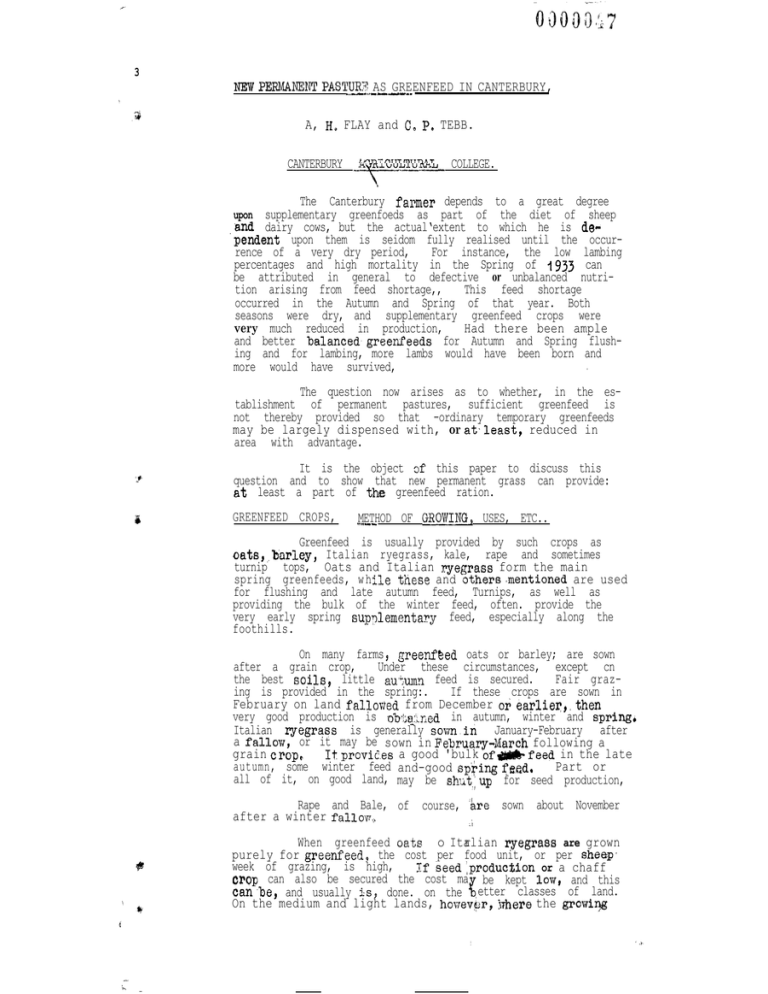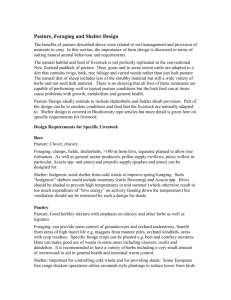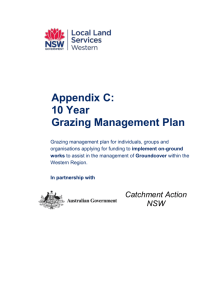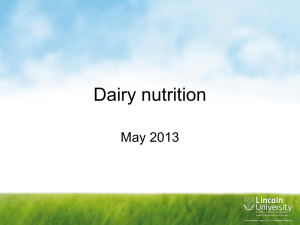NEW PERMAl!%ENT PASTURX AS GREENFEED IN CANTERBURY, -.~--...-.----v
advertisement

I
3
NEW PERMAl!%ENT PASTURX
AS GREENFEED IN CANTERBURY,
-.~--...-.----v
A, H, FLAY and C, P, TEBB.
CANTERBURY
AflRiCULTURAL
COLLEGE.
--Y---The Canterbury farmer depends to a great degree
upon supplementary greenfoeds as part of the diet of sheep
,and dairy cows, but the actual‘extent to which he is dspendent upon them is seidom fully realised until the occurrence of a very dry period,
For instance, the low lambing
percentages and high mortality in the Spring of 1933 can
be attributed in general to defective or unbalanced nutrition arising from feed shortage,,
This feed shortage
occurred in the Autumn and Spring of that year. Both
seasons were dry, and supplementary greenfeed crops were
very much reduced in production,
Had there been ample
and better balanced,greenfeeds
for Autumn and Spring flushing and for lambing, more lambs would have been born and
.
more would have survived,
The question now arises as to whether, in the establishment of permanent pastures, sufficient greenfeed is
not thereby provided so that -ordinary temporary greenfeeds
may be largely dispensed with, or at%least, reduced in
area with advantage.
It is the object of this paper to discuss this
question and to show that new permanent grass can provide:
at least a part of the greenfeed ration.
GREENFEED CROPS,
METHOD OF GROVQNG,
.,...--
USES, ETC..
Greenfeed is usually provided by such crops as
oats,,,barley, Italian ryegrass, kale, rape and sometimes
turnip tops, Oats and Italian ryegrass form the main
spring greenfeeds, w hile t'riese and others.mentioned
are used
for flushing and late autumn feed, Turnips, as well as
providing the bulk of the winter feed, often. provide the
very early spring supplementary
feed, especially along the
foothills.
On many farms o greenfeed oats or barley; are sown
after a grain crop,
Under these circumstances, except cn
the best soils9 little au?umn feed is secured.
Fair grazing is provided in the spring:.
If these crops are sown in
February on land falloWed from December or earlier,.then
very good production is o3-:;g:lned
in autumn, winter and springi
Italian ryegrass
is generally sownin January-February after
a fallom, or it may be sown in Febrqary-March
following a
grain crop*
It provid.es a good 'bulk of#feed in the late
autumn, some winter feed and-good sp'ring feed.
Part or
all of it, on good land, may be shut.!up for seed production,
Rape and Bale, of
after a winter fallovr,,
c
course, '&re
sown about November
.i
When greenfeed oa,ts o Italian
r
ryegrass are grown
purely for greenfeed? the cost per food unit, or per sheep.
week of grazing, is high,
If seed1producM.on
or a chaff
Crop can also be secured the cost ma be kept 10~~ and this
canbe, and usually %s, done. on the 3: etter classes of land.
On the medium and light lands, howev,&r, inhere the growi*
of large areas of green crops is the general practice, greenfeed and a cash crop cannot be secured satisfactorily orprofitably from the s.arn.3 sowing,
I
PRESENT METHODS
GRASS.
- OF - SOVING
---w.--
,
Many farmers sow grass-with turnips, kale .or
rape, and sometimes even with oats in the autumn.
The
threefold object in adopting this procedure is to obtain
a batter
balanced supplementary feed,
I
cheap sowing, and
a permanent pasture following the supplementary
:
iI
crop without the necessity of further tillage.
Although the resultarlt thin and open sward usually
indicates the method of sowing, -i.n a normal season on light
land the first and third objects are generally gained.
T h e
second, cheap sowing9 may prove to be false economy, however,
-cJhen
the weed invasion and lowered production resulting from
the bare spaces of such a pasture are considered over a
period of years,.
On heavy land the supplementarytcrop,
if as good as it should be, often smothers the young establishing pasture to a large extent,
In either case, the young grass,is severelytr3;Sted
(I) by the heavy tramping in the autumn and nicker when
the higher yielding crop is being grazed9,:and
(2) by severe grazing in the c.ase of rape and kale at
a very early stage"
In connection with the latter considerat,ion, it is characteristic of the sheep to eat out the
lesser and more palatable constituent before turning to-the
more bulky crop,
In general, the practice of sowing permanent pasture along with a supplementary feed crop is unsatisfsctory,
Because of the smothering and the early severe grazing, but
little autumn, winter or lambing greenfeed5i.s
obtained from
the new pastures sown nith these supplementary crops,
PERXANENT
PASTURE- - ESTABLISHMENT,
.---Nom from the point of view of season and fallow,
with the exception of sowing immediately after a grain crop9
permanent pasture sown alone on a firm and weed free seed
bed could.be established in the place of any of the crops
that have been under discussion above,
9
*,
The best method of permanent pasture establishment, "
whether it be on heavy or light land, is,that of sorting a
suitable mixture of truly permanent strains alone on a properly prepared 'and well f;illovJed seed bed.
The length of
time between original ploughing and. the sowing should not
be less than three months,
Deep cultivation should be
completed at least 6 y-ieeks before the intended soming date,
and this final period should be filled in with surface aorking only; that is, suitable light harrowing and rolling
that will result in moisture conservation and need control,
and mill leave, ultimately, a fine, 'firm, moist weed-free.
seed bed,
Sowing a pasture under such conditions in October or November, on almost any soil, givex a good germination,
a rapid establishment and complete cover.
Where properly
regulated grazing is maintained"p particularly in the first
The new pasture
year, a good permanent pasture is assured,,
provides lucious grazing as greenfeed: as soon as it is several
(3)
inches
SEED
high.
MIXTURE,
The grass seed mixture hhich is recommended for
maximum greenfeed production and a permanent pasture, and
which can be grazed hard for a short time if absolutely necesw?,?
is the dominant ryegrass
type as follows:ary
True or certified perennial.ryegrass
307351b;
Akaroa cocksfoot
acre
.
R e d
c l o v e r
z E
Wild or certified white clover
* I- 21b.
With the price of certified ryegrass at 6/- per
bushel, cocksfoot-at l/i per pound, red colver at IOd per
pound and white clover at l/g per pound, the mixture may
vary in cost between 18/- and 24/-, say $1, per acre.
To those ac@ustomed
to sowing temporary lines of
seed this cost may seem excessive.
That this is not sop
however, may be apprecitited by a consideration of the long
term view.
The cultivation costs are no more for the establishment of this permanent pasture than for the,sor;;ring of a
temporary pa.sture.
As against greetieed
alone, the-cost mny- appear
even more excessive, but is easily offsetby the cultivation,
weding and mnnuring costs of greenfeed production over a
period of say, five years9 during,the.whole
of which time
the one permanent pasture is involving no other expenditure
than that for annual top-dressing,:.
SPRING OR AUTUMN SOBING FOR PERMANENT PASTURE AND THE
MAXIMUM GREENFEED PRODUCTION'THEREFROM?
Good ryegrass'pasturc
establishment,may
be obtained
by autumn sowing, and on heavy land in a high state of fed-’
ility early autumn sowing of cocksfoot and ciovers may.be
highly successful.
Because of better veed control, early
aritumn or summer soning on.heavy or weed infested land is
prcf erred.
The degree of success, -although dependent upon
the weather experienced at and after sovingp will vary with
The$e
the length of fallow and fitness of the seed bed.
pastures usually give late autumn greenfeed for late lmnbs,
for flushing of ewes, and abundant spring greenfeed,
It
would probably be April, at the enrlies-t, before grazing
could be commenced - assuming a February sowing.
Sov~ing
should generally take place not later,thnn
the end of March.
On the medium and light land, spring and early
summer sowings are not affected, as a rule, by the annual.
weeds that are troublesome
on the heavy lands. ,Along the
foothills uf Canterbury, however, spurry (or garr) may be,
troubleaomc in certain areas,
Although December sowing
is desirable on these foothill lands, January and February
sowings on v{ell fallowed land make a rapid and thorough
establishment,on
account of the favourable r&r&all conditions that generally prevail.
On these areas extrtimely
e
n
obtained
by
sowing alone in Novgood pastures ha&$%
ember and December on well fallowed land after turnips.
+
-, '_
-
On every class Of land the earlier the sowing c&n
take place the lcnger will be the "greenfeed" season.. On
light land, pasture sown at the end of September should be
peady for grazing'in December.
According to the conditions
of rainfall and fertility such a pasture will give greenfeed
throughout the autumn and up to October of the following
._
spring.
Regardless of the time of sovJing the "greenfeed"
value of the pasture disappears vr-ith the approach of the
November following the daj;e of sowing, because firstly the
ryegrass ,(especially on the lighter soils), tends to shoot
rapidly to seed at this time, and secondly there is usually
A
adequate feed from the other grazing pasttires.
In genera!., and -especially on medium and light
land, spring ‘and early summer sonings are the best for
sccuring"eenfeed and a good mixed pasture, and should
be aimed a'E wherever t.illage and need conditions mill permit.
USES AND MANAGEMENT-.-I_
OF NEX -?-PFXI~7&&BXL' PASTURE.
'In a season of average rainfal1.a nevf permanent
pasture of the type described, and sown in October or NOVember as indicated, shLuld.be ready:for n-light grazing in
the latter part of January au:'.the beginning of.February.
Throughout the autumn, provided that rainfall is adequate
and nor' -westers are not too 1"rcq~en.-l->~ such a pasture provides
,useful greeqfeed, and, if reserved for special purposes such
as lamb fattening or flushing of evles and rams, allows a
reduction in area of feeds grown for these purposes*
It is recorded that such a pasture on medium land
will, throughout the autumn period, fatten 5 or more lambs
With &lb
per acre without supplementary hand f'eeding.;
wheat per 1,amb daily, 8-10'lCambs per acre .can be fattened.
This fattening 'should no%,%&re than a 2'on 3 months .pex?io'd.
Late autumn feed, some winter feed and spring lamb-.
in@; feed can be obtained by spelling the new pasture pending
Except in the case of
the use to which it ls to be put,
'
lamb or cull ewe fattening, this pasture should, lof. course9
be rationed at the rate of 2 or more hours per day aswis
now good prabtice with.greenfe,eds,
..
z
In the spring, ewes and lambs should be'put on fn
groups of several days lambing, or mobs of ewes and 1~ .lti
At
lambs may be put on breaks for several hours daily.
no time should the pasture be eaten hard for any lengthy
period.
This is important, particularly if the cocksfoot
and cbovers are to be given a fair start,
The permanent pasture sown in October, November
or December will then, under average rainfall conditions,
assist in the provision of the follo~~ing.~- lamb fattening
feed, flushing fetid, late au~mn feed, some,ninter greenfeed,
spring flushing feed and lambing feed up to Oytober - November following sowing,
At this time the ryegrass begins to shoot to seed,
and the whole or part of such a pasture may be ,shut up for
Sf a high yield 'of easily cut seed'
a profitable seed crop.
is desired, shutting up in the middle of September for medium and light land, and the midfdle ok, end of October for
medium to heavy-land is necessary,
If not to be used for seed. production, the pasture
may be grazed in the usun,7 manner throughout the spring.
Under ordinary grazing conditions
a payable yield of seed
may be obtained by means of sCripping,
Gentle or light grazing from October onwards allcns
the cocksfoot and c10oe.i:~ to recover after the closer grazing
/
(5)
during
lambing,
By spelling the pasture from mid-November
to about the' end of December, a bulk of succulent grazing
may then be obtained from the clover content of the pasture,
in late December and January at a time when it is most '.valuable for maintaining ewes and lambs in a thriving condition.
The ryegrass
that shoots to seed during this
!'spelli'ngtt period, even if it is not stripped, need not
cause any concern, because under Canterbury conditions, if
asture and stock are to receive the best treatment, and
i":$%mb production is the object, some seed stalks cannot
‘b.e avoided - even with continuous grazing,
The best treatment for the pasture is to allow seed stalks to develop;
for the sheep, to secure Eat lambs off the mothers. If
grazing in the first year is allowed to be hard enough to
prevent the growth of seed stalks, then cocksfoot and'clover
development is very poor,, the value of the pasture in January - February is lost and fat lamb production is proportionately retarded.
\.
.'
CARRYING CAPACITIES OF NEW PERMANENT PASTURES USED AS GREENFEG.
Although there are no comparative figures for greenfeed oats, Italian ryegrass
and new permanent pastures grown
under experimental and exactly similiar conditions, yet records have been kept of the grazing obtained from new permancn$.pasture
when grazed al though it were greenfeed. ~
A few representative figures are given in:the
following
table.
A
,
.eeb or Ewes
Light Land
(Foothills)
Nov.
1933.
I
an, :
b’eb.
Suly ’
hug ..
e3h
ct.
1 ova
P ec,
r
$3.05
B2n31
0.91
I.84
;'~~
6:%
2,64
-.
&
z.73
rn*‘z
ay ’
kk”p,
oeo7
$2.
5 * 20 ., .,>
2.30
.k w
1 .40 ‘\‘\ g?
t
I
so6
-
Shut Sned
Went Flat
& only 2c
bus'. per
ac. saved
Records have also been kept of the grazing obtained
, fron'greenfeed'oats
and from Italian ryegrass whenever opportunityr permitted.
Some of these figures are given below:-
TABLE II.. Carrying Capacity of Greenfeed Oats Bc Italian
Ryegrass When Used as Greenfeed;
Dry Sheep 'or Ewes per
prr
aYe
une
9 . 2 8
,-
July
0.11
3.18
1.15
OQ73
0.95
3.94
4;23
ec.
-
It is not intended that these tables should be ,
t‘aken a&truly comparative of the grazing capcity of new
'permanent pasture as against that of greenfeed,
.but the figures do indicqte. that new.permanent
pasture,sown
alone,in,
the fashion outlinedrks capable,under ordinary circumstances, ':
of giving satisfacto&high grazing when used as greenfeed,
1t.shouj.d be stated that the examples recorded above have
; been used because the methods of tillage and seed-bed pre-.
pnration, and the grazing procedure are known to have been
most satisfactory..
CONCLUSIONS
Where permanent pastures are desired, Twhether it
be on heavy or light land farms, the method of establishment
,and grazing mnnagemcnt as outlined is economically applic-'
able to at least one paddock each year.
Such a m
&&&M&# allons some reduction,at least in
the area of costly temporary feeds; on account of 'the method
and time of soming,successful
establishment is almost certain;
by correct management valuable feed is obtainable at every
.special "greenfeed" season for a period'of
approximately
one year; the production of a valuable'strain
of seed is
;;s;ss$ ;~a;:; f$yst$%rvest year if des;red, ,but otherwise
A@? .my permanent first class pasture
is
established.
This last consideration, on all farms,
except those of the dominantly cropping type, and they are
.
fea; cannot help but appeal to the farmer who has tried the
method thoroughly.
The greenfeed value of Italian ryegrass, when sown
after a lengthy period of fallow has been well established,
then why not permanent pasture for greenfeed after a similiar fallow, on all fnrms where permanent pastures&re'desired?
This method-of establishing and managing new permanent grass has become a definite part.& a profitable
programme on a large number of Canterbury:.farms.







